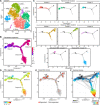Shared transcriptional profiles of atypical B cells suggest common drivers of expansion and function in malaria, HIV, and autoimmunity
- PMID: 34039612
- PMCID: PMC8153733
- DOI: 10.1126/sciadv.abg8384
Shared transcriptional profiles of atypical B cells suggest common drivers of expansion and function in malaria, HIV, and autoimmunity
Abstract
Chronic infectious diseases have a substantial impact on the human B cell compartment including a notable expansion of B cells here termed atypical B cells (ABCs). Using unbiased single-cell RNA sequencing (scRNA-seq), we uncovered and characterized heterogeneities in naïve B cell, classical memory B cells, and ABC subsets. We showed remarkably similar transcriptional profiles for ABC clusters in malaria, HIV, and autoimmune diseases and demonstrated that interferon-γ drove the expansion of ABCs in malaria. These observations suggest that ABCs represent a separate B cell lineage with a common inducer that further diversifies and acquires disease-specific characteristics and functions. In malaria, we identified ABC subsets based on isotype expression that differed in expansion in African children and in B cell receptor repertoire characteristics. Of particular interest, IgD+IgMlo and IgD-IgG+ ABCs acquired a high antigen affinity threshold for activation, suggesting that ABCs may limit autoimmune responses to low-affinity self-antigens in chronic malaria.
Copyright © 2021 The Authors, some rights reserved; exclusive licensee American Association for the Advancement of Science. No claim to original U.S. Government Works. Distributed under a Creative Commons Attribution NonCommercial License 4.0 (CC BY-NC).
Figures







Similar articles
-
Atypical B cells in chronic infectious diseases and systemic autoimmunity: puzzles with many missing pieces.Curr Opin Immunol. 2022 Aug;77:102227. doi: 10.1016/j.coi.2022.102227. Epub 2022 Jun 17. Curr Opin Immunol. 2022. PMID: 35724448 Free PMC article. Review.
-
The development and function of CD11c+ atypical B cells - insights from single cell analysis.Front Immunol. 2022 Aug 22;13:979060. doi: 10.3389/fimmu.2022.979060. eCollection 2022. Front Immunol. 2022. PMID: 36072594 Free PMC article. Review.
-
Understanding the Heterogeneous Population of Age-Associated B Cells and Their Contributions to Autoimmunity and Immune Response to Pathogens.Crit Rev Immunol. 2020;40(4):297-309. doi: 10.1615/CritRevImmunol.2020034934. Crit Rev Immunol. 2020. PMID: 33426819 Free PMC article.
-
Age-associated B cells expanded in autoimmune mice are memory cells sharing H-CDR3-selected repertoires.Eur J Immunol. 2018 Mar;48(3):509-521. doi: 10.1002/eji.201747127. Epub 2018 Jan 15. Eur J Immunol. 2018. PMID: 29266242
-
Malaria-induced interferon-γ drives the expansion of Tbethi atypical memory B cells.PLoS Pathog. 2017 Sep 27;13(9):e1006576. doi: 10.1371/journal.ppat.1006576. eCollection 2017 Sep. PLoS Pathog. 2017. PMID: 28953967 Free PMC article.
Cited by
-
Development and longevity of naturally acquired antibody and memory B cell responses against Plasmodium vivax infection.PLoS Negl Trop Dis. 2024 Oct 24;18(10):e0012600. doi: 10.1371/journal.pntd.0012600. eCollection 2024 Oct. PLoS Negl Trop Dis. 2024. PMID: 39446698 Free PMC article. Review.
-
Alternative B Cell Differentiation During Infection and Inflammation.Front Immunol. 2022 Jun 24;13:908034. doi: 10.3389/fimmu.2022.908034. eCollection 2022. Front Immunol. 2022. PMID: 35812395 Free PMC article. Review.
-
BAFF system expression in double negative 2, activated naïve and activated memory B cells in systemic lupus erythematosus.Front Immunol. 2023 Aug 22;14:1235937. doi: 10.3389/fimmu.2023.1235937. eCollection 2023. Front Immunol. 2023. PMID: 37675114 Free PMC article.
-
Development of high affinity antibodies to Plasmodium falciparum merozoite and sporozoite antigens during infancy and adulthood.Front Immunol. 2025 Jul 2;16:1562671. doi: 10.3389/fimmu.2025.1562671. eCollection 2025. Front Immunol. 2025. PMID: 40672955 Free PMC article.
-
Differences in phenotype between long-lived memory B cells against Plasmodium falciparum merozoite antigens and variant surface antigens.bioRxiv [Preprint]. 2024 Jun 3:2024.06.01.596978. doi: 10.1101/2024.06.01.596978. bioRxiv. 2024. Update in: PLoS Pathog. 2024 Oct 28;20(10):e1012661. doi: 10.1371/journal.ppat.1012661. PMID: 38895251 Free PMC article. Updated. Preprint.
References
-
- Amanna I. J., Carlson N. E., Slifka M. K., Duration of humoral immunity to common viral and vaccine antigens. N. Engl. J. Med. 357, 1903–1915 (2007). - PubMed
-
- World Health Organization, World malaria report 2018 (World Health Organization, 2018).
-
- Cohen S., Mc G. I., Carrington S., Gamma-globulin and acquired immunity to human malaria. Nature 192, 733–737 (1961). - PubMed
Publication types
LinkOut - more resources
Full Text Sources
Other Literature Sources
Molecular Biology Databases

